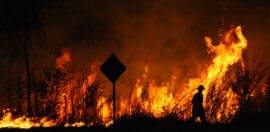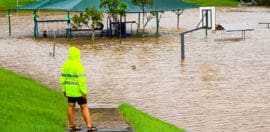The country is not waiting for the government

4 November 2019 at 5:07 pm
The Australian government may not have a credible mechanism for reducing the emissions that are driving global warming. But huge amounts of climate action can and is occurring outside of what the government does, writes Greenpeace Australia Pacific CEO David Ritter, as part of a series on Fighting Global Warming in your Workplace.
In this series of articles, I have been writing about what every workplace can do to stand up and be counted in the climate emergency. But here’s a question for you. Why are we even having this conversation?
Let’s go back to the federal election night on 18 May this year. At our place, my wife and I and our two daughters sat around the TV with some of our best mates and their kids. We’d ordered in some local pizza – to top off the democracy sausages that, of course, everyone had eaten earlier in the day.
Now, I think it is fair to say, the results of the night were mixed.
On the upside, the pizza was absolutely excellent. And watching elections with your children might not necessarily be as fun as teaching them to swim or ride a bike, but it is important and certainly memorable. Let’s face it – some of the weirder features of our democracy are just not that easy to explain.
On the downside, though, the result was that the Morrison government was returned without a shred of credible climate and energy policy to its name. My 10-year-old daughter’s verdict was to tell me that, Dad, “this is a little bit scary”. And my daughter was right.
The election result was scary, because the climate emergency is upon us and severe climate damage is already affecting our country causing havoc to nature and inflicting hurt and harm on tens of thousands of Australians, through heat-waves, floods, storms, droughts, fires and ecological disasters, and with worse to come.
Now so far Scott Morrison’s new government has shown disdain for the world’s most eminent experts and scientists who are calling for urgent action to reduce emissions. It is a response that is worse than negligent. They have no credible mechanism for reducing the emissions that are driving global warming. And they have no plan at all for phasing out coal – which is the biggest driver of the climate emergency in Australia. But worse still, Angus Taylor, Scott Morrison, and company seem to be actively looking for ways to prop up big coal, through increasing the already massive government subsidies to the fossil fuel sector.
And coal doesn’t only pollute our climate. Coal pollutes our air and water, and coal directly damages our health. One recent study found that there are 279 premature deaths a year from air pollution from coal-burning power stations in NSW alone.
The first duty of government is the security and safety of citizens and in the context of the climate emergency, our politicians are failing dismally to discharge that duty.
So, it is indeed all more than a little bit scary.
But great change is non-linear and history is unpredictable. Since the election, we have seen an incredible, unprecedented surge in climate activism in our country, across all sectors and all geographies of our national community: people of Australia who are showing themselves determined to make hope possible.
Speaking from a Greenpeace perspective, we’ve experienced an unparalleled rush of new people wanting to be involved, including tens of thousands signing up online, hundreds joining up for training with Greenpeace all around Australia, and the establishment of more than 40 new local groups.
All over Australia, communities are organising anew, to demand the early closure of ageing, dirty, dangerous, polluting coal-fired power stations.
And of course, the phenomenon is wider than Greenpeace. We are seeing a huge surge in support for the school strikers for climate, as parents, teachers, carers, community members, institutions of all kinds and both unions and businesses turned out in their thousands.
In locations all over Australia, we are seeing communities rising up and demanding climate emergency declarations from their local governments. More than 50 municipal governments representing more than six million people have now declared a state of climate emergency.
All of this goes to show that Morrison’s coalition government and the nation of Australia are not the same thing. The government is not the country – and the country is not waiting for the government.
What this series of articles in Pro Bono News has been all about is the amount of climate action that can be taken, even if our federal government is festering in negligence and denial. Huge amounts of climate action can and is occurring outside of what the commonwealth government does. Cities, towns, states, territories, businesses – institutions of all kinds – all of these can take action.
The need for leadership has never been greater, but if our politicians won’t step up and do their job, then it is up to the rest of us. And perhaps if Scott Morrison and his government and all the politicians in Canberra, do not have the wit or courage to lead, then as the rest of the nation leaves them behind, may they find the wisdom and decency to do the right thing – and follow.
You can join the Greenpeace network here or keep up to date with our latest campaigns here or here.
This is an edited version of a speech given as part of Climate Change and Australia: Where to Now? a public lecture in the Ideas and Society Program at La Trobe University. The full proceedings can be watched here.
There should be no business as usual in your workplace this FridayDon’t Buy. Don’t Supply. Say Why.
How your workplace can be energy-efficient







